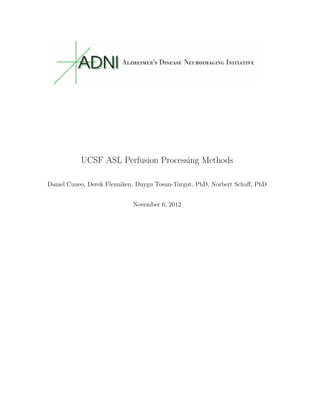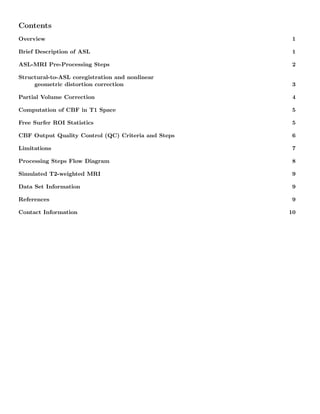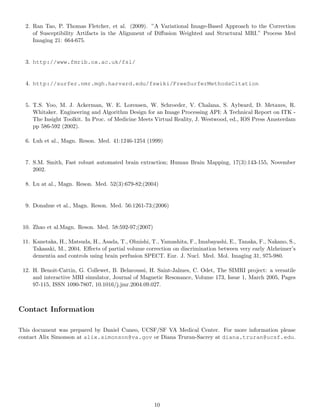This document describes the UCSF pipeline for processing arterial spin labeling (ASL) MRI data to produce cerebral blood flow (CBF) maps. The pipeline involves motion correction, computation of perfusion-weighted images (PWI), co-registration of ASL and structural MRI data, geometric distortion correction, partial volume correction, and quantification of CBF values. The outputs include PWI and CBF images in the ASL and structural MRI spaces, as well as regional CBF statistics within anatomically defined regions of interest. Limitations include the distortion correction method not accounting for intensity variations, scaling not accounting for regional relaxation rate variations, and partial volume correction not accounting for regional perfusion ratio variations.


![Overview
The Center for Imaging of Neurodegenerative Diseases (CIND) processing pipeline for Arterial Spin Label (ASL)
imaging, prepares perfusion-weighted images (PWI) and computes a quantitative map of cerebral blood flow
(CBF) and a regional analysis. The quantification of CBF and correspondence to high-resolution anatomical
MRI data, is achieved by implementing multiple tools from the public domain such as, SPM8 [1], EPI nonlinear
geometric distortion correction [2], various FSL tools [3], FreeSurfer [4], Insight Toolkit (ITK) [5] and in house
MATLAB scripts.
In brief, the pipeline performs 1) motion correction of the individual ASL frames, 2) computation of the PWI
by subtracting the mean of tagged from untagged ASL data sets, 3) alignment of ASL and structural MRI data,
4) geometric distortion correction, 5) partial volume correction, 6) and CBF quantification in physical units by
normalizing ASL to an estimated blood water density signal.
The outputs include the PWI and a CBF image, both corrected for EPI distortion in two representations: a) in
native perfusion MRI space and b) in the subject-specific space of the corresponding structural MRI data. Each
output offers users a variety of options for further processing and analysis of the data, such as subject-specific
analysis using anatomical regions of interest or group-specific analysis, such as parametric mapping.In addition,
summary measures of CBF within anatomically defined brain regions are provided separately.
Brief Description of ASL
The concept of ASL provides a means of measuring cerebral blood flow (CBF) completely noninvasive by
exploiting the endogenous spins of arterial water as a proxy for blood flow. Labeling (or tagging) is achieved by
selectively inverting the magnetization of the arterial spins using MRI principles. After a short delay, allowing
the arterial spins to reach the brain, conventional MRI methods are used to map the spatial distribution of the
ASL signal. The signal to noise ratio of ASL signal is inherently low due to intense background signal from
tissue water. Therefore, the ADNI-2 ASL acquisition protocol requires a set of 52 pairs of repeated tagged and
untagged image frames which are then averaged to increase the SNR.
Many variants of ASL have been developed over the years, such as continuous, pulsed, and velocity selective
labeling. Here, we describe a pipeline to process a version of pulsed ASL method referred to as “QUIPSS II with
thin-slice TI1 periodic saturation” or “Q2TIPS” [6], augmented by conventional echo-planar imaging (EPI),
which has been used in ADNI-2. In Q2TIPS, arterial spins are labeled within a thick (≈ 10 cm) inversion slab,
placed proximal to the imaging slices, as shown in the figure below. The critical timing parameters of Q2TIPS
for quantifying flow are the ASL bolus duration and the transit delay from the time of inversion to the time of
EPI mapping.
1](https://image.slidesharecdn.com/18ddae40-bb9a-47eb-977e-73ca9fda4815-150519213102-lva1-app6891/85/LONI_ASL_DOC-3-320.jpg)
![Diagram of ASL regions
http://www.birncommunity.org/wp-content/uploads/2009/08/4077_Rasmussen.pdf
ASL-MRI Pre-Processing Steps
1. Motion Correction: The ASL image series is converted from DICOM to NiFTI format. Each frame is
aligned to the first frame to correct for head motion, by a rigid body transformation and least squares
fitting, using SPM8.
2. PWI Computations: The ASL images are arranged in groups of tagged and untagged scans and the mean
of each group is computed and saved as an image. Then the difference of the mean-tagged and mean-
untagged images (meantagged −meanuntagged) is taken to obtain a PWI. In addition, the very first untagged
ASL image, which provides a fully relaxed MRI signal, is used as a reference of water density and termed
M0. The reference image is primarily used to calibrate the ASL signal for computations of the CBF and
also as an intermediate frame to estimate the transformation to co-register between images from the ASL
MRI and structural MRI. In this capacity, the M0 is used as the blood-water-density proxy, Mblood, see
below.
3. Intensity Scaling: The PWI image as well as the M0 image, are intensity scaled. The PWI is scaled to
account for signal decay during acquisition and also to provide intensities in meaningful physical units.
The M0 is scaled to become Mblood, that is, water to blood density.
Description of PWI Scaling: PWI intensities are corrected for the longitudinal relaxation of the spin
tracers during data acquisition, including time lags between consecutive image slices, as well as for incomplete
labeling. Assuming an ascending slice order at acquisition with n = 1 indicating the first slice, the intensity
correction for the nth slice is:
PWIlag−corr =
PWIraw
2αTI1
e[R1a(TI2+(n−1) τ)]
, (1)
where α is the tagging efficiency, R1a is the longitudinal relaxation rate of blood, TI1 is the inversion time of
arterial spins and TI2, is the total transit time of the spins, n is the nth slice, and τ is the time lag between
slices.Specific intensity correction parameters used in our implementation are reported in Table 1. R1a is a
2](https://image.slidesharecdn.com/18ddae40-bb9a-47eb-977e-73ca9fda4815-150519213102-lva1-app6891/85/LONI_ASL_DOC-4-320.jpg)
![biological parameter whereas TI1, TI2, and τ are specific to ADNI-2 acquisition protocol. The resultant image
in the native ASL image space is provided in units of blood flow.
Intensity Scaling of M0: The control (M0) image is scaled to estimate a map of the blood magnetization,
Mblood by correcting for the lower density of tissue water relative to arterial blood water, λ , and for the different
relaxation characteristics of tissue and arterial blood water,as follows:
Mblood =
M0
λ
e(R∗
2tissue− R∗
2blood)TE
, (2)
where λ is the blood/water ratio in tissue, R∗ are the two relaxation rates and TE is the blood relaxation time.
See table 1 for the parameter values.
Table 1
Parameter Values
α 0.95
λ 0.90
τ 22.5 ms
TE 12 ms or 13 ms protocol specific
TI1 700 (ms)
TI2 1900 (ms)
R1a 1/1684 (kHz) [8]
R∗2tissue 1/44 ms [9]
R∗2blood 1/43 ms [10]
Computing A CBF in ASL Space: A CBF map in the ASL space, can be formed with the Mblood and
the PWIlag−corr, using,
CBFASL =
PWIlag−corr
Mblood
. (3)
Structural-to-ASL coregistration and nonlinear
geometric distortion correction
EPI-based perfusion images suffer from nonlinear geometric distortion due to magnetic susceptibility variations
whereas structural MR images are less susceptible to geometric distortions. This is a key challenge in achieving
an accurate anatomical match between data from ASL-MRI and structural MRIs. We use a variational image-
based approach to correct for these EPI-induced nonlinear geometric distortions in ASL-MRIs.
The geometric distortion correction step is performed in the PWI native space. Instead of using the T2∗ image,
we use a simulated T2 weighted image, made from the T1 in the acquisition series. The T2 simulation process
is briefly described in the appendix.
The processing steps for nonlinear geometric distortion correction areas follows:
• SimT2 image is masked leaving a layer of sulcal CSF around the brain.
3](https://image.slidesharecdn.com/18ddae40-bb9a-47eb-977e-73ca9fda4815-150519213102-lva1-app6891/85/LONI_ASL_DOC-5-320.jpg)
![• Mblood is skull stripped with BET [7] and coregistered to the masked T2 using the normalized mutual
information metric with 9 degrees of freedom.
• Masked SimT2 is down sampled to the Mblood space and named, T2rPWI.
• Distortion correction performed on the Mblood using the T2rPWI and the correction field applied to the
PWI.
Partial Volume Correction
We are interested in the blood flow of gray matter tissue (GM), which is bounded by cerebrospinal fluid (CSF)
and white matter (WM) tissues. To correct for variations in both PWIlag−corr and Mblood due to variable
coverage of GM, WM and CSF at each voxel, both images are corrected for the tissue partial volume effects
before computation of a CBF map.
Both PWIlag−corr and Mblood maps are first upsampled to the T1-weighted MR image space using trilinear
interpolation and inverse affine transformation estimated to coregister simulated T2 to masked Mblood.
The PWIlag−corr intensities are adjusted voxel wise, according to GM and WM tissue density distributions
estimated using 4 tissue segmentation provided by SPM8, and assuming a constant ratio between GM and WM
matter perfusion. The intensities are corrected according to,
PWIgm = (PWIrT1)
[
GM
GM + 0.4WM
.
]
(4)
Here, PWIrT1 is the PWIlag−corr resliced to T1 image space. βGM and βWM are the volume fractions of gray
matter and white matter respectively.
In this partial volume model of PWIrT1, we assume that signal at each voxel is a weighted linear combination of
perfusion from GM and WM, with the weighting coefficients expressing perfusion in terms of the corresponding
tissue densities (i.e., βi for i = GMi , WMi) and the ratio of GM to WM perfusion is spatially constant at 2.5
value (Kanetaka et al., 2004) [11].
A similar PVC is performed for the Mblood . In contrast to PWI, however, partial volume correction for the tissue
water reference image needs to include CSF. Partial volume correction of the Mblood is computed according to,
Mblood−PV C = (MrT1−blood)
[
γGM
(
γ−1
GM + γ−1
1 WM + γ−1
2 CSF
)]
+ κ . (5)
The ratios of tissues to water are,
γ =
GM
H2O
= 0.78 , γ1 =
WM
H2O
= 0.65 , γ2 =
CSF
H2O
= 0.97 ,
and
κ =
1 −
∑
(GM + WM + CSF)
1 × 10100
.
4](https://image.slidesharecdn.com/18ddae40-bb9a-47eb-977e-73ca9fda4815-150519213102-lva1-app6891/85/LONI_ASL_DOC-6-320.jpg)




![Appendix: Simulated T2-weighted MRI
A framework to simulate subject-specific T2-weighted MR images was engineered by Dr Duygu Tosun-Turgut.
The framework is based on the work by Benoit-Cattin et al.[12] To mimic clinical neuroimaging practice, we
chose the following 2D Turbo Spin Echo (TSE) sequence parameters for simulated T2-MRI.
Parameter Value
TR 3210 ms
TE 101 ms
slice thickness 3 mm
resolution 1 × 1 mm
flip angle 150◦
bandwidth 185 Hz
GRAPPA 2
T2-MRI simulation steps are as follows:
In brief, the steps to make a simulated T2 are:
• Create a binary brain tissue mask from FreeSurfer ’aparc+aseg’ anatomical annotation.
• Apply a morphological closing operator followed by a morphological dilation to eliminate holes in brain
mask and to include sulcal CSF.
• Apply resulting brain mask to T1-MRI, yielding skull-stripped T1 image.
• Downsample skull-stripped T1 image to 1 × 1 × 3 mm3 image resolution to mimic clinical neuro imaging
practice.
• Apply a fuzzy c-means clustering algorithm to estimate GM,WM, and CSF tissue density at each image
voxel in downsampled skull-stripped T1 image space
• Based on selected acquisition parameters and tissue density estimates, simulate a T2-MRI.
Each 2D axial slice is simulated separately and finally merged back to form a simulated 3D T2-MRI.
Data Set Information
UCSF ASL FS Uploaded on November 1st, 2012
References
1. http://www.fil.ion.ucl.ac.uk/spm/
9](https://image.slidesharecdn.com/18ddae40-bb9a-47eb-977e-73ca9fda4815-150519213102-lva1-app6891/85/LONI_ASL_DOC-11-320.jpg)
